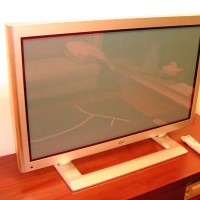Yes, theVooner bought a Plasma TV.
Once in your life you make one of those purchases that is just out of the world. Your first car, your first house, etc. Ok, this isn’t really the same league, but to me it sort of feels the same. In HK, buying a place is less than ideal. First, property values are especially expensive. But getting a 5% yield while paying for a 7% mortgage (yes, the lower interest rate environment means the rate is lower now, but we’re close or at the bottom now) just doesn’t add up in my books.
Buying a car is also grotesquely expensive in Hong Kong. Not so much for the car price, but the fact that a car park rental in my new building costs HK$3500 (US$450) per month, my office costs HK$2200 (US$280) per month, and the average carpark in the mall is HK$32 (US$4) per hour. Add it up and it’s a big waste of money considering there are plenty of cabs around Hong Kong. Yeah, I might still get one someday, but just not right now. The Plasma TV is one of those extravagant purchases that you can’t really justify. In fact, I’m not even going to try. Who cares — I have a Plasma TV!
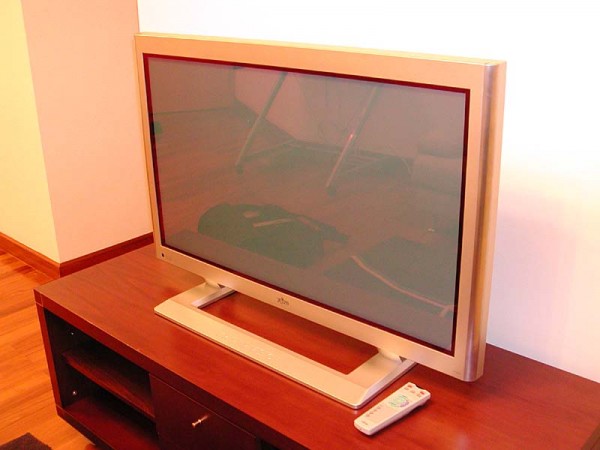
Fujitsu PDS4221 - 42" Plasma Display View 1
I’ve wanted a Plasma for sometime now. They are just amazing. When they first came out, more than a year ago, they cost well over HK$120k (US$15k). The quality was suspect; rumors circulated about problems with the screens/image. It was all just one big dream that looked like it would be forever before it came true. In time, there were more models available and the prices continued to fall. I recently saw the older (what I call 1st Generation) Plasma available for under HK$38k (US$4.9k). To me, that’s pretty reasonable. I went to the store and checked out all the different models. I of course fell for the newest models available.
There were really only 2 Plasma screens that are new that are worth considering. One is the Sony and the other the Fujitsu. In truth, I’m a huge Sony fan. I’d wear Sony clothes if they made it. So I was originally expecting to buy the Sony Plasma 42B1U. It’s a beautiful Plasma but after closer inspection, I found some small problems with it.
First, the Fujitsu had a better picture than the Sony. I suppose I could have tweaked with the colors on the Sony and I might have gotten it to look better, but even the guy at the store said the Fujitsu was superior (though you can’t always trust a salesman). By “better” I mean it was clearer, brighter, had more “detail” and just seemed a better screen overall when compared side-by-side. (I should add that I read somewhere, though I could be wrong, that Sony sources the Plasma screens from Fujitsu. So technically, it could be the same screen just configured differently.)
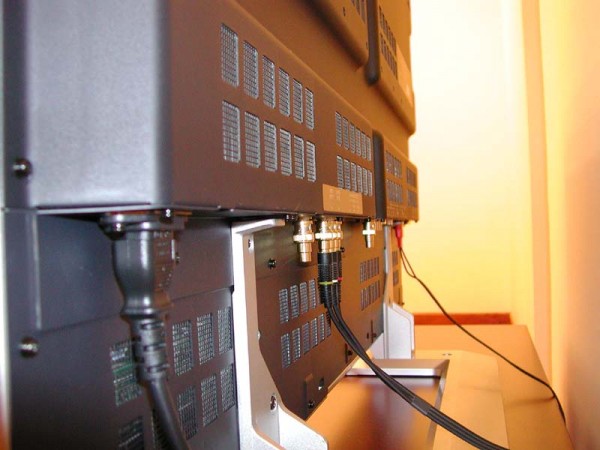
Fujitsu PDS4221 - 42" Plasma Display View - Back
The two key factors that iced the deal in favor of the Fujitsu are 1) the input connections, and 2) the built in amplifier with external speaker options. First, in comparing the Sony and the Fujitsu, the Sony comes with 2 RGB ports for which you can get various adapters to connect different devices. The connections are also at the right side of the screen. The input for audio is not unlike a walkman mini-jack. It just all seemed like it was designed for business applications (connection of a PC) rather than for consumers like me. The Fujitsu though comes with a plethora of connections at the back. Composite, S-Video, Video, separate BNC and RGB ports. It was cool. All the ports are BNC, but the shop provided me with BNC to RCA adapters so its essentially the same as any TV. It’s thus a breeze to hook up a DVD, Video, game console, whatever. The Sony requires an adapter to break up the RGB into separate parts. I don’t know, it just didn’t seem right to me.
Then there is the built-in amp. We’ll talk about the sound later, but if you wanted to add speakers, you can because the Fujitsu has a built-in amp with speaker outputs to plug in any standard speakers. (I had my eye on a Bose AM3 or a Blueroom Minipod so I thought this could be useful.) In the end though, it wasn’t necessary as I’ve got a Nakamichi Soundspace 8 that I’ll hook my DVD up to (review on that will follow later). But still, it’s a useful option for those wanting to connect some speakers (which is actually important as I later point out).
BTW, for those wanting to know what the difference is between the 4221 and the 4222. One is supposed to be a consumer model and the other a business one. Other than that they are pretty much the same. (One is also a Class A compliant while the other is a Class B – I’m not sure what that means.)
Form
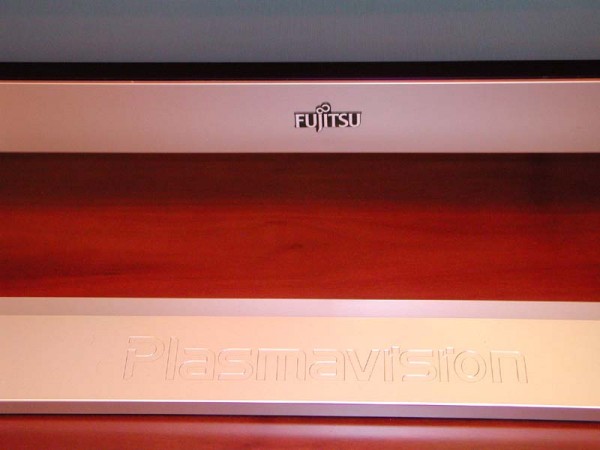
Fujitsu
The Fujitsu PDS4221 is simply beautiful. How else can I explain it? There isn’t much to describe here. Solid aluminum feel, amazing size, it’s just incredible. Fujitsu can definitely build an amazing Plasma TV, but they have no idea how to build a remote. The remote control is one of the most pathetic ones I have ever seen. It has a total of about 9 buttons. A simple example of how badly I think the design of the remote is: there are separate on and off buttons, which somehow is just annoying. Thank goodness I bought the Sony RM-VZ950T universal remote. I programmed my universal remote and just threw the Fujitsu remote in the drawer.
It is also a pain and extremely difficult to set up the stand for the Plasma. The instruction manual they give you is just dismal. It is both laborious and time-consuming to get it put together. Funny thing too, as thin and amazing as the Plasma is, these things are pretty heavy. Some 75 pounds, these things take some strength to carry. I ended up putting a small scratch on my new TV stand because I wasn’t watching what I was doing when I placed the TV on the table.
Function
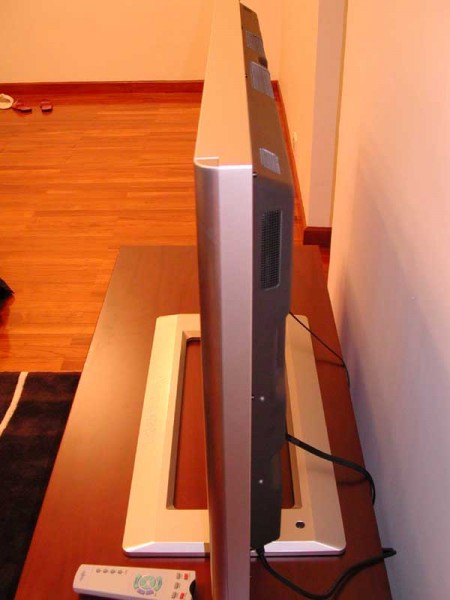
Fujitsu PDS4221 -42" Plasma Display View - Side
A TV is a TV – that is until you get a Plasma. Now THIS is a TV! The first thing you notice is that the screen is HUGE. The 42” TV is so much bigger than my 29” Wega, even if it is a widescreen. The 16:9 perspective takes a little getting used to. When you playback a DVD, you still get the black bars at the top and bottom, unless you choose to use the different options for the screen. You get a standard screen (designed for regular images like TV in 4:3), a Wide format, and a Zoom format. After playing around with each, I came to the conclusion that the wide format is the best. While the zoom format fills in the screen better, it ends up doing some weird things to the picture. I don’t know how to describe it — it’s sort of a weird, distorted image. I don’t like it. While it fills the entire screen, the image doesn’t look as good. It’s sort of like maximizing the window of a video clip that plays on your computer. You suddenly start to notice distortions. The wide mode though keeps everything wonderful. I’m used to black bars above and below, and this one maintains the “proper” aspects the best.
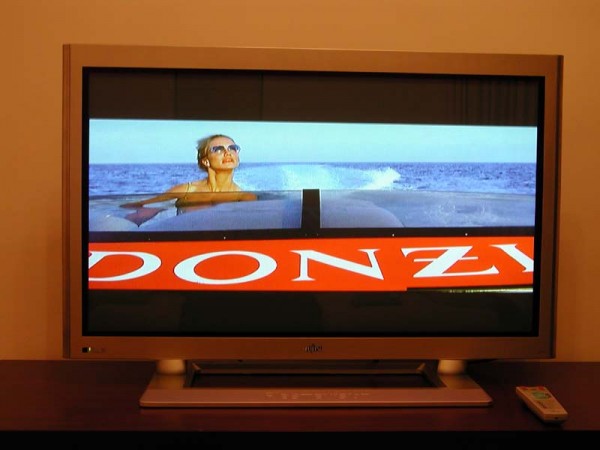
Fujitsu PDS4221 -42" Plasma Display View - Front
I popped in both Gladiator and Charlie’s Angels. Wow! Visually stunning. Enough said. My problem though was the sound. At maximum volume, using the built in speakers, you can barely hear Cameron Diaz kick-ass. Oh well, if you’re going to splurge on a Plasma, you shouldn’t skimp on the sound. Anyway, after two days of watching movies with “low” sound, the Nakamichi Soundspace 8 arrived and I hooked it up. At last, a true cinematic experience. The conclusion is that the Fujitsu is just a screen — don’t expect good sound. I had a chance to recently play with the Sony Plasma 42B1U and I can say that I had a similar experience with its built-in speaker. Hence, if you get a Plasma, you should definitely have something else like an amp or surround sound processor that can give you decent sound. Any Plasma isn’t just a stand alone TV as you would get from say a Sony Wega.
Picture quality is bright and vibrant, even for regular TV. You have a number of options to tweak the image as much as you want — color, contrast, tint, etc. I should also add that one of the reasons why I decided to pay a major premium and buy the latest model was because this one is much better designed for the consumer. I call this Plasma a 3rd generation plasma. The resolution is now 1024×1024, at least 2 steps above past models. What I like the most about these newer Plasmas are that they are brighter. You can just look at them to know this is true. The older models are now selling at some 30-50% below the model I bought. But they aren’t as bright. Why? Well, there’s a pretty easy explanation. The original Plasmas were designed for business users and business applications. Hence, you’d see them in shopping malls, airports, etc. Because these screens tend to be “on” some 18-24 hours a day, I was told that their screen brightness were turned down so the screens would in essence last longer and consume less power. Consumer models though aren’t used that much, well, they’re not meant to be anyway. There are a few people I know that park themselves in front of the TV all weekend, but not everyday — even we need to get out sometime. Hence, the newer models have started to get brighter. This in turn has led to better quality pictures.
Factor
In the end, how can I complain? I have a Plasma! It’s expensive, but worth every penny I paid for it. Getting a Sony or a Fujitsu is a personal decision. At this very point in time, I think the Fujitsu is the best Plasma out there. I love Sony so if you get that one, you probably didn’t go wrong either. I just think that, for all of the reasons above, the Fujitsu is THE choice. As far as TVs go, this is one ESSENTIAL buy. I’m sure we’ll all eventually move towards one in the future. But I admit, the price is a huge deterrence. Plasma’s should slowly get cheaper and if you want one of the older models, they are relatively cheap. A Plasma should last a fair amount of time, so for a 5-10 year investment, it’s definitely worth it.
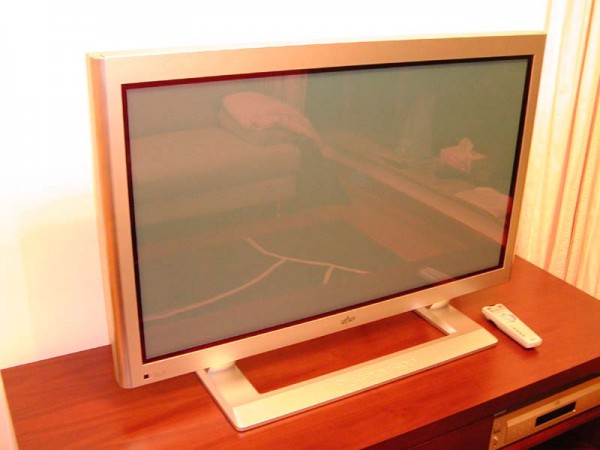
Fujitsu PDS4221 - 42" Plasma Display View 2
